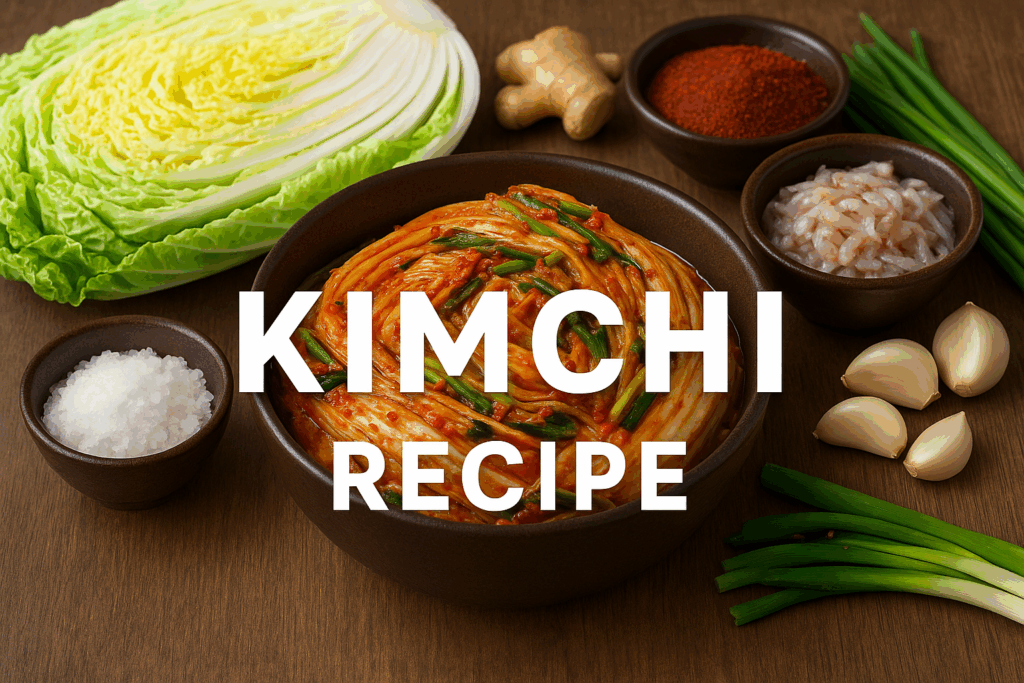Introduction
Kimchi, a cornerstone of Korean cuisine, is a fermented vegetable dish renowned for its bold flavors and health benefits. This guide will walk you through the traditional process of making kimchi at home, ensuring you capture the authentic taste and texture that has made it a global favorite.

What Is Kimchi?
Kimchi is a traditional Korean side dish made by fermenting vegetables, primarily napa cabbage and Korean radish, with a flavorful blend of seasonings. The fermentation process not only preserves the vegetables but also imparts a distinctive tangy flavor and introduces beneficial probiotics, promoting gut health.
Essential Ingredients
To create authentic kimchi, gather the following ingredients:
- Napa Cabbage: The primary vegetable used in traditional kimchi.
- Coarse Sea Salt: Used for salting the cabbage, drawing out moisture, and initiating fermentation.
- Korean Radish (Mu): Adds crunch and sweetness.
- Garlic and Ginger: Provide depth and warmth to the flavor profile.
- Gochugaru (Korean Red Pepper Flakes): Imparts the characteristic heat and color.
- Fish Sauce or Salted Shrimp (Saeujeot): Adds umami richness.
- Sugar: Balances the flavors and aids fermentation.
- Green Onions: Introduce a fresh, mild onion flavor.
Equipment Needed
- Large Mixing Bowl: For salting and mixing ingredients.
- Colander: To drain the salted cabbage.
- Gloves: Protect your hands from the chili paste.
- Fermentation Container: A glass jar or traditional onggi pot works well.
Step-by-Step Instructions
1. Preparing the Cabbage
- Cut and Rinse: Slice the napa cabbage lengthwise into quarters and remove the core. Rinse thoroughly under cold water.
- Salting: Sprinkle coarse sea salt between the leaves of each cabbage quarter. Place them in a large bowl and let them sit for 2 hours, turning occasionally. This process draws out excess moisture and begins the fermentation process.
- Rinse and Drain: After salting, rinse the cabbage quarters under cold water to remove excess salt. Drain well and set aside.
2. Making the Kimchi Paste
- Prepare the Base: In a bowl, combine minced garlic, grated ginger, gochugaru, fish sauce (or salted shrimp), and sugar. Mix well to form a thick paste.
- Add Vegetables: Julienne the Korean radish and chop the green onions. Add them to the paste and mix until all components are well coated.
3. Applying the Paste
- Coating the Cabbage: Wearing gloves, take each cabbage quarter and spread the kimchi paste between each leaf, ensuring even coverage.
- Rolling: Once coated, roll each quarter into a tight bundle.
4. Fermentation
- Packing: Place the kimchi bundles into your fermentation container, pressing down to eliminate air pockets.
- Initial Fermentation: Leave the container at room temperature for 1-2 days, depending on the ambient temperature.
Tips for Perfect Kimchi recipe
- Salt Selection: Use coarse sea salt, as its larger grains are ideal for drawing out moisture without over-salting.
- Fermentation Time: The length of fermentation affects the flavor. Shorter fermentation yields a fresher taste, while longer fermentation results in a more sour profile.
- Storage: Use airtight containers to prevent contamination and odor transfer. Traditional onggi pots are excellent but not necessary.
Health Benefits of Kimchi
Kimchi is rich in probiotics, which support digestive health. It’s also high in vitamins A, B, and C, and contains beneficial compounds like capsaicin from chili peppers, which may boost metabolism.
Variations of Kimchi
While napa cabbage kimchi is the most well-known, there are numerous variations:
- Kkakdugi: Cubed radish kimchi.
- Oi Sobagi: Stuffed cucumber kimchi.
- Baek Kimchi: White kimchi made without chili flakes, offering a milder flavor.
Serving Suggestions
Kimchi can be enjoyed in various ways:
- As a Side Dish: Served alongside rice and other main dishes.
- In Soups and Stews: Adds depth and flavor to broths.
- In Fried Rice: Kimchi fried rice is a popular comfort food.
- In Pancakes: Kimchi pancakes (kimchijeon) are a savory treat.
Conclusion
Making kimchi at home is a rewarding culinary endeavor that connects you with Korean tradition and offers a delicious, healthful addition to your meals. With patience and practice, you’ll master this iconic dish and perhaps even develop your own signature version.
Table of Contents

